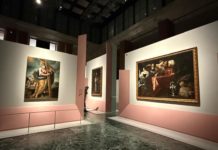Liminari: spazi corporei e visioni interiori (foto) è la seconda mostra del progetto “La materia dei luoghi immaginari”. Verrà inaugurata domani, sabato 23 novembre, alle 19.30 alla galleria Sabato Angiero Arte di Saviano.
Nell’idea espositiva il corpo umano emerge come un palcoscenico complesso e affascinante, un vero e proprio spazio immaginario che riflette non solo l’identità individuale, ma anche le esperienze, le emozioni e le memorie. Ogni corpo è un universo unico, custode di storie e significati, dove la materia si intreccia con l’immateriale, creando un dialogo continuo tra esterno e interno.
Nella storia dell’arte, il corpo è stato frequentemente utilizzato come simbolo di vulnerabilità e forza. Artisti di diverse epoche e correnti hanno esplorato la corporeità per affrontare temi complessi come la violenza, l’identità e la guarigione. Attraverso performance, pittura, fotografia e installazioni, l’arte ha dato forma a esperienze di trauma e riscatto, trasformando il dolore in un potente messaggio di denuncia.
Frida Kahlo e Marina Abramović hanno utilizzato il proprio corpo come terreno di esplorazione del dolore e della sofferenza: Kahlo ha tradotto le sue esperienze di malattia e violenza in opere cariche di simbolismo, dove il corpo diventa un riflesso del suo tormento interiore; Abramović ha messo in scena il suo corpo in performance che esplorano i limiti fisici e psicologici, sfidando gli spettatori a confrontarsi con la vulnerabilità umana.
Nella fotografia contemporanea, Cindy Sherman e Zanele Muholi hanno utilizzato il corpo per esplorare le identità di genere, la sessualità e le esperienze di oppressione. Le loro opere invitano il pubblico a riflettere su come il corpo venga percepito e rappresentato, evidenziando le ingiustizie e i pregiudizi presenti nella società.
La concezione del corpo come spazio immaginario invita a ripensare come viviamo e utilizziamo il nostro essere. Non siamo solo architetti dei luoghi fisici, ma anche dei nostri corpi, plasmando e dando forma a una realtà che è tanto soggettiva quanto universale. La nostra esistenza si svolge in un continuo dialogo tra il corpo e l’ambiente, in cui ciascuno di noi è un creatore, un esploratore, un narratore della propria esperienza. Le mostre personali di Irene Angelino, Rosa Catalano e Paola Tassetti sottolineano le diverse visioni di corpo creando nuovi immaginari.
Il corpo, considerato come spazio, è un luogo di esplorazione e di scoperta. Non è statico, ma vive, respira, si muove, e con ogni gesto racconta una narrazione. Le sue forme e proporzioni, le sue cicatrici e fragilità diventano simboli di esperienze vissute, di sfide affrontate e di momenti di bellezza.
La materia non è solo un contenitore, ma un’entità dinamica che interagisce con il mondo circostante, riflettendo e influenzando le emozioni e le percezioni. Questa riflessione sull’immaginario corporeo di ogni artista arricchisce il nostro approccio alla materia e all’architettura, invitandoci a considerare come ogni spazio, ogni luogo, possa essere anche un corpo in cui abitare, sognare e creare. Così, il corpo umano si rivela come opera d’arte in continua evoluzione, simbolo di connessione tra il visibile e l’invisibile.
Saturday Angiero Arte/ Irene Angelino, Rosa Catalano and Paola Tassetti reveal the body as a space of imagination
Liminari: corporeal spaces and inner visions (photo) is the second exhibition of the project ‘The matter of imaginary places’. It will be inaugurated tomorrow, Saturday 23rd November, at the Sabato Angiero art gallery 19.30 at the in Saviano.
In the exhibition idea, the human body appears as a complex and fascinating stage, a real imaginary space that reflects not only individual identity, but also experiences, emotions and memories. Each body is a unique universe, a repository of stories and meanings, where the material and the immaterial intertwine, creating a constant dialogue between the outside and the inside.
Throughout the history of art, the body has often been used as a symbol of vulnerability and strength. Artists from different eras and movements have explored the physical to address complex issues of violence, identity and healing. Through performance, painting, photography and installation, art has shaped experiences of trauma and redemption, transforming pain into a powerful message of denunciation.
Frida Kahlo and Marina Abramović used their bodies as sites for exploring pain and suffering: Kahlo translated her experiences of illness and violence into symbolically charged works in which the body became a reflection of her inner torment; Abramović staged her body in performances that explored physical and psychological limits and challenged viewers to confront human vulnerability.
In contemporary photography, Cindy Sherman and Zanele Muholi have used the body to explore gender identities, sexuality and experiences of oppression. Their work invites audiences to reflect on how the body is perceived and represented, highlighting the injustices and prejudices that exist in society.
The concept of the body as an imaginary space invites us to rethink how we live and use our being. We are not only architects of physical spaces, but also of our bodies, shaping and giving form to a reality that is as subjective as it is universal. Our existence takes place in a constant dialogue between body and environment, in which each of us is a creator, an explorer, a narrator of our own experience. The solo exhibitions of Irene Angelino, Rosa Catalano and Paola Tassetti highlight different visions of the body and create new images.
The body, considered as space, is a place of exploration and discovery. It is not static, but lives, breathes, moves and tells a story with every gesture. Its shapes and proportions, its scars and fragility become symbols of lived experiences, challenges and moments of beauty.
The body is not just a container, but a dynamic entity that interacts with the world around it, reflecting and influencing emotions and perceptions. This reflection on the corporeal imagery of each artist enriches our approach to matter and architecture, inviting us to consider how any space, any place, can also be a body in which to live, dream and create. The human body is thus revealed as a constantly evolving work of art, a symbol of the connection between the visible and the invisible.










